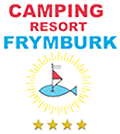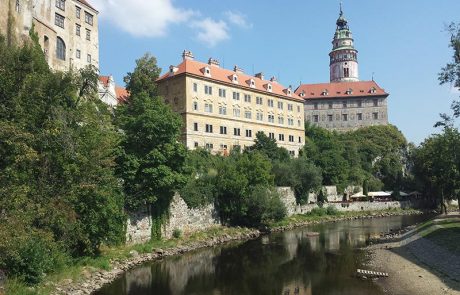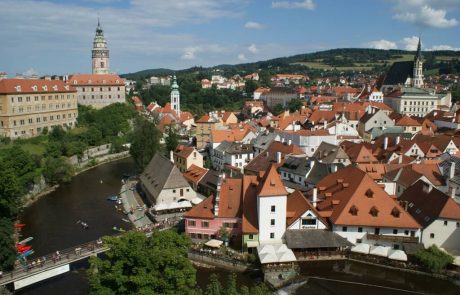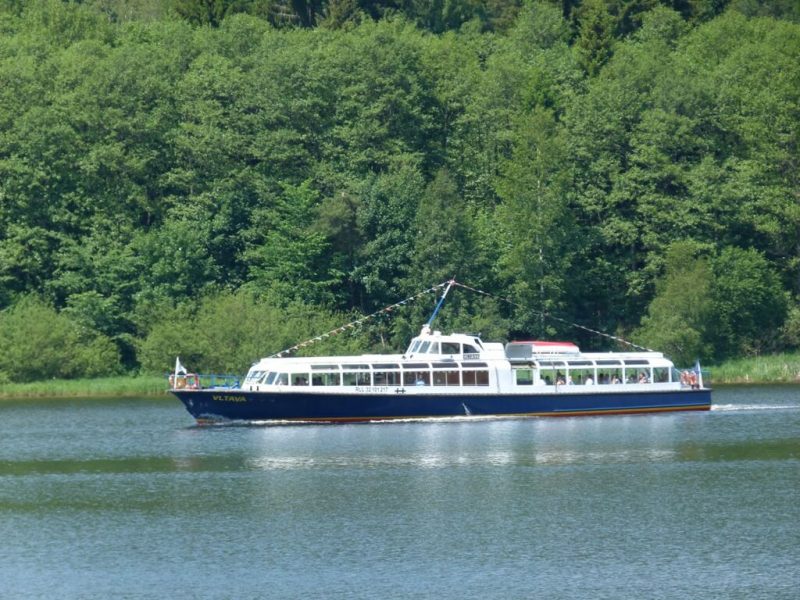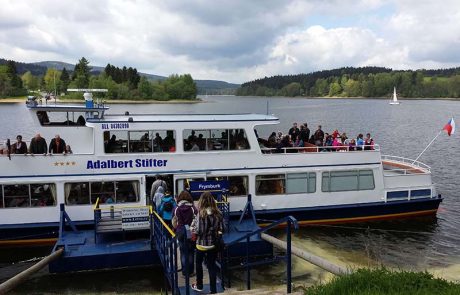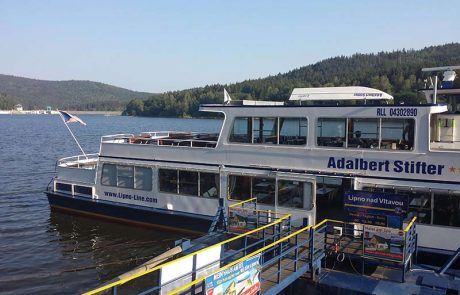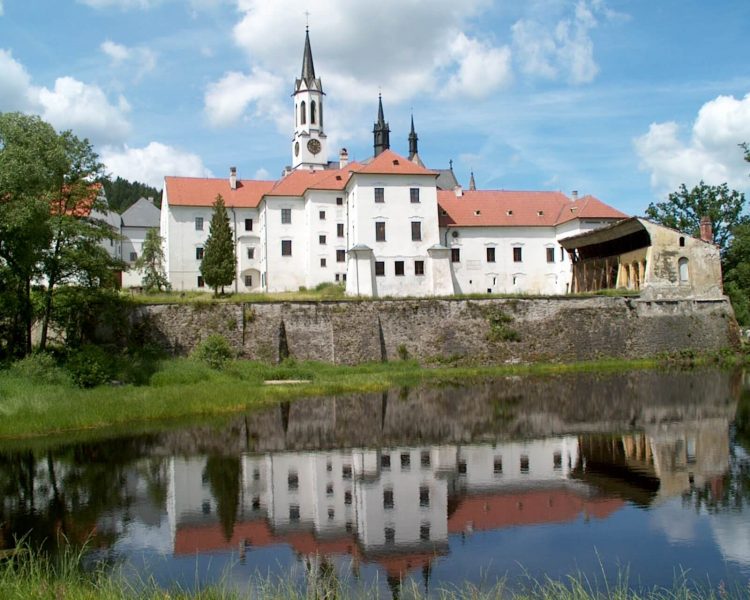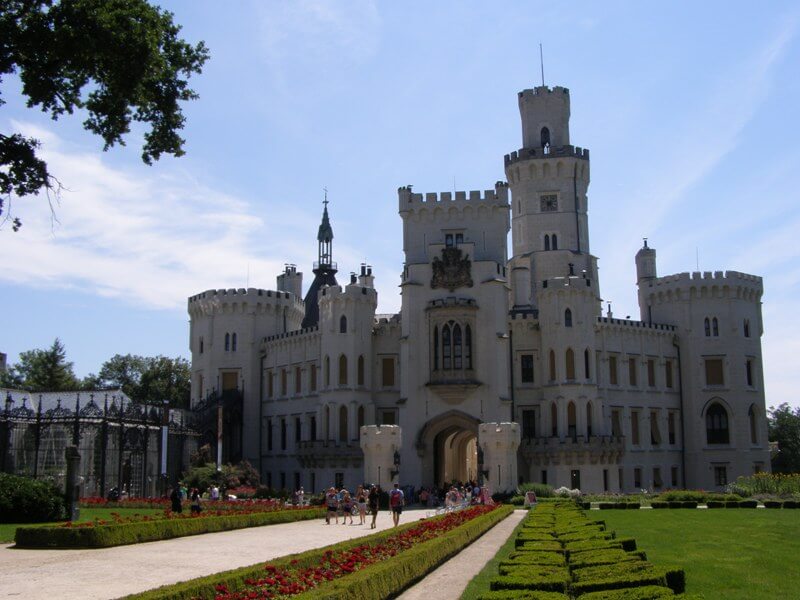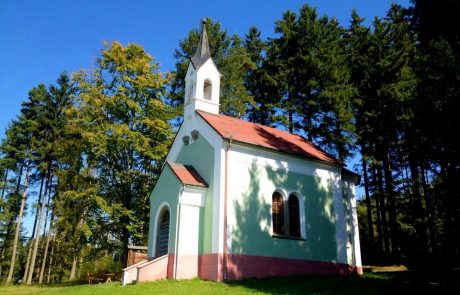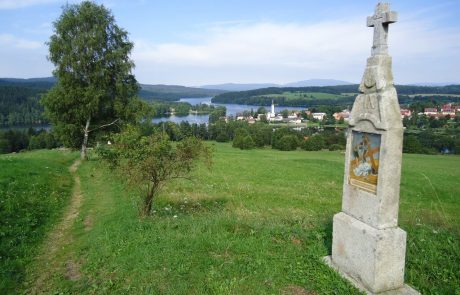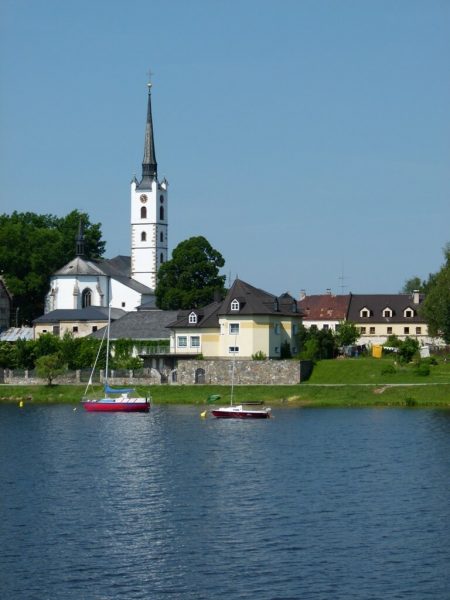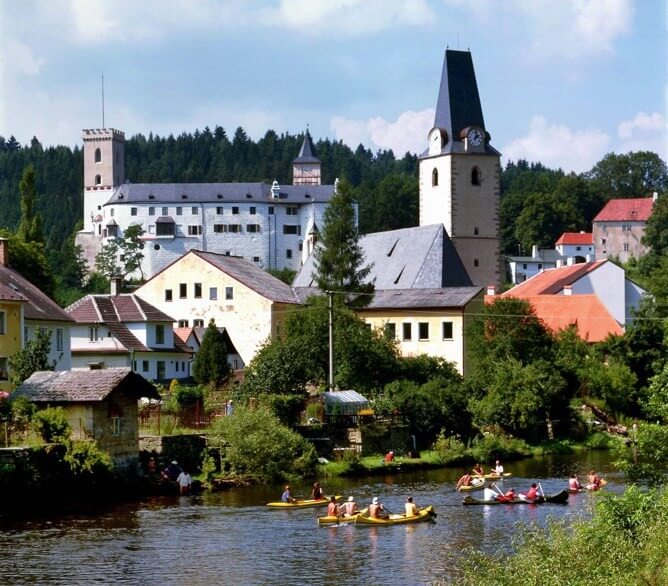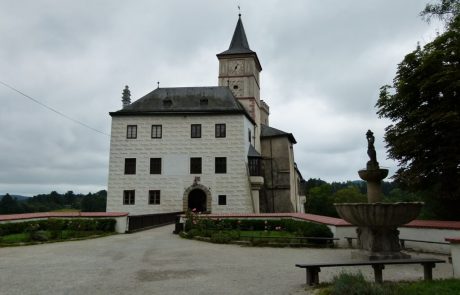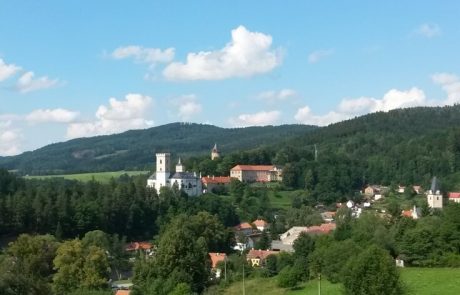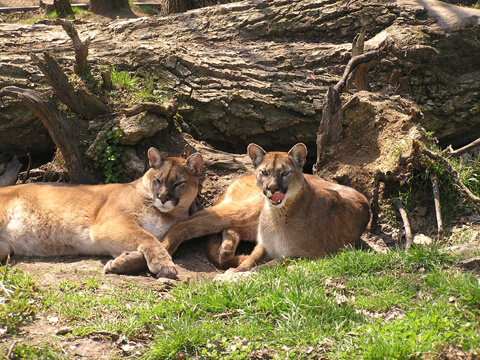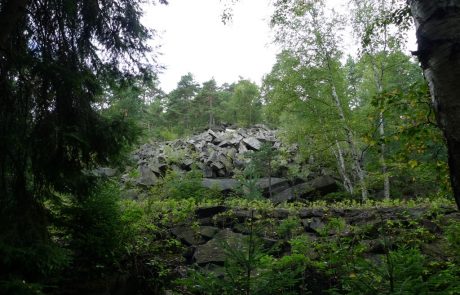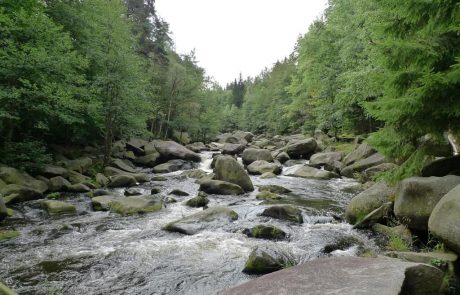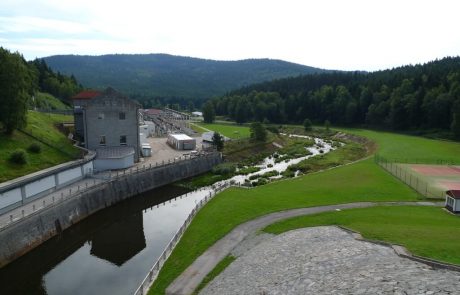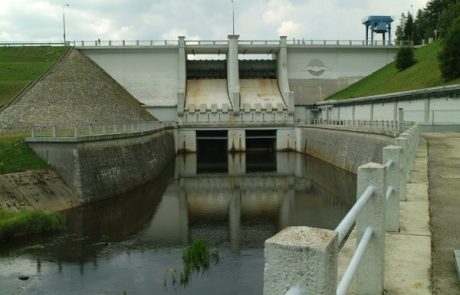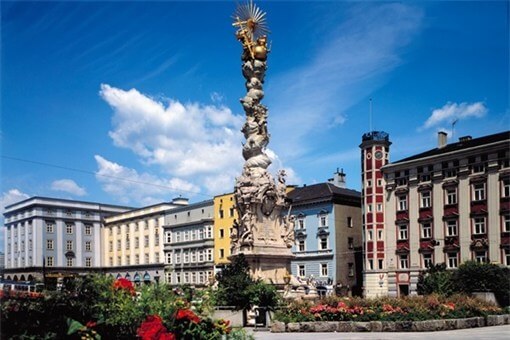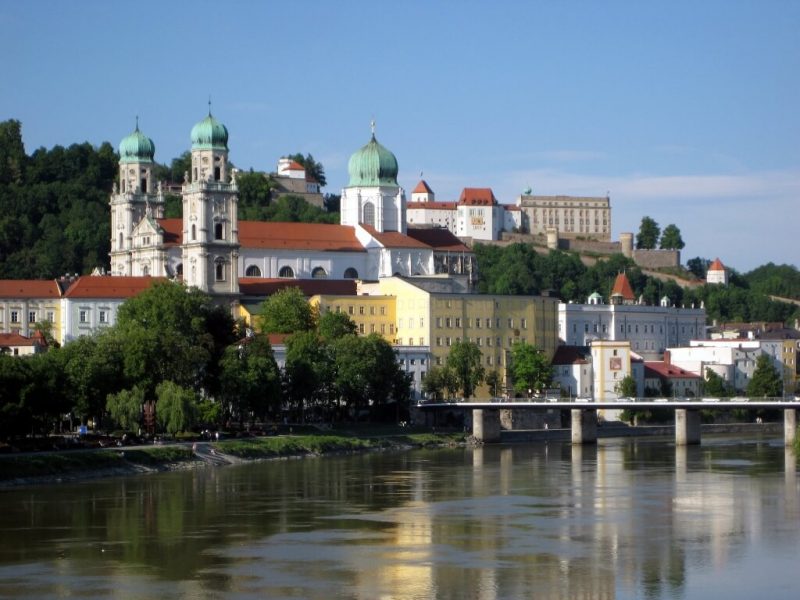Český Krumlov (UNESCO castle and historical city, 23 km)
Český Krumlov, the pearl of South-Bohemia, was placed on the list of the world’s most important monuments by UNESCO in 1992. Strolling along the streets of Český Krumlov is an experience on its own, but there are also several sights:
- The Castle, Zámek 59. Open daily from April until October, except Mondays (these opening hours apply for almost all castles in the Czech Republic).
- Also the Castle’s park is worth of visiting and here you can watch a theatre play from a rotating tribune, a splendid spectacle. Daily shows in July and August, except Sundays.
- The international arts and culture centre Egon Schiele at Široká street 70 – 72 with its original artworks and documentation about the painter also provides season exhibitions with works of famous painters and sculptors.
- In the Regional Museum, a ceramic model of the city can be found, as well as an exhibition with the title “A historic view of the region Český Krumlov from the beginning of time until the 19th century“.
- The Gothic Vitus church originating from the early 15th century.
- Brewery Eggenberg at Latrán 27 is open for visitors all year. Tours with degustation on request.
- The graphite mine is possible to visit in July and August daily from 9 a.m. till 5 p.m. In June and September during the weekends. Address: Chvalšinská street.
- Finally: in the second half of June, the traditional feast of the Five Leaved Rose is held. It seems you are back in the middle ages with people dressed in ancient costumes, a fair, renaissance plays, living chess and at night the many midsummer parties.
Vyšší Brod (20 km)
Just outside the town, you will find the Gothic Cistercian monastery dating from 1259 with its unique library of 70 000 books and a postal museum. The monastery was damaged several times by fire. The church’s present furnishing was restored during the forties of the 17th century in a mainly Baroque style. Also the abbey, which now serves as a postal museum, dates from this period, as well as most of the farm buildings next to the monastery. The monastery’s library was founded in 1757 and contains rare manuscripts and is certainly worth visiting.
Castle Hluboká nad Vltavou (10 km from České Budějovice)
Castle Hluboká has much resemblance to the English Windsor Castle. It was built in the last century, when the old castle was demolished. The castle holds 144 rooms and halls, loaded with art. You will find religious art from the period 1450 till 1530.
Castle Hluboká is surrounded by a beautiful park, worth a visit. There is also the zoo ZOO Ohrada. This is 2 km away from the castle.
České Budějovice (50 km)
It is a beautiful city with plenty guarded parking places (watch the “P” signs).
In the centre of the city you can find a square with sides of 133 m. The square is dominated by the city hall which was rebuilt between 1727 and 1730. At the roof you can see the statues “Justice” “Wisdom” “Courage” and “Providence”.
The Samson fountain, which has been build between 1721 and 1727, is located in the middle of the square and along the sides of the square you will find little shops with lots of Bohemian crystal, gold and silver and lots of cosy terraces.
Kleť near České Budějovice
The highest mountain (1084 m) lays in the nature reserve the Blanský forest. There are hiking paths, marked with signs. From Krasetín at village Holubov a cable car leads to the top of the mountain. At the top, you can find a mountain shelter with a restaurant and the oldest stone watchtower at the Bohemia, dating from 1825. At a clear day, the Alps can be seen from here. Also the highest observatory of the Bohemia can be visited.
Zlatá Koruna
is a small village at the river Moldau. Its Cistercians monastery was founded by King Přemysl Otakar II. in the year 1263 and was annihilated in 1785. It is possible to visit the monastery. The visitor’s route takes you through the oldest part of the monastery, the chapel of the Protecting Angels. There is also an exposition on South Bohemian literature to visit.
Way of the crosses
A short, steep walk of about 2 km. This Way of crosses from 1894 to hill Marta was renovated in the years 1999 and 2000. Along the route you will find 14 crosses and at the top the renovated chapel “The High Torment”. This trip provides a splendid view over Lake Lipno. At the different crosses, there are benches to have a rest and take pictures.
Frymburk
This picturesque South Bohemian town of Frymburk spreads at the foothills of Šumava at the altitude of 730 above the sea level. It is a unique town thanks to its exquisite location extending on the peninsula situated on the left bank of Lipno Reservoir which means that the town is largely surrounded by the waters of the „Šumava Sea“ and at the same time is located in the proximity of the Austrian borders. You can pass the state border through the border crossing Guglwald/ Přední Výtoň 10 km far from Frymburk. This town was originally founded as a merchant village at the end of the 13th century and was situated on the trading path leading from Upper Austria to Český Krumlov. However pre-historical findings prove that the location was settled from 8 to 10 thousand years B.C. The status of town was attributed to Frymburk in 1379 and the town brewery was established in 16th century.
Svatý Tomáš and ruins of castle Vítkův Kámen (16 km)
On the opposite shore from the camping, several walking and bike routes are indicated, e.g. the route to Svatý Tomáš village. This one is very beautiful, but rather steep. Only take this trip if you are trained well enough and use a bike with enough gears. All roads to Svatý Tomáš are tarred. Here it is if you were alone at the world. At the top, the little church can be visited.
If you follow the path from the church up, you get to the ruins of Vítkův Kámen (1035 m), since 2005 it is a lookout tower. From here you have a wonderful view over the Lake Lipno and the Alps in Austria if the weather is nice.
Rožmberk (30 km)
Driving into the direction of Rožmberk, you can see castle ROŽMBERK nad Vltavou at a distance; in the Moldew valley the castle lies on a hill and is worth a visit. The upper castle was built in the first half of the 13th century, the lower one only 100 years later. The last renovation was carried out in the middle of the 18th century, in a New Gothic style. The castle holds rich collections of paintings, furniture, dishes and utilities as well as an arms room and the family museum of the Buquoys.
Rožmberk and its lovely surroundings attract many tourists.
THE PATH AMONG TREES Lipno nad Vltavou
The first road among trees in the Czech Republic offers a unique combination of experience to its visitors. The road is 675 m long and it is embodied in the landscape of Lipno lake. On the road you can find a 40-m-high tower including an outstanding viewpoint. You can also try 11 adrenalin stops which are built up along the road. The supreme experience is the longest spiral chute in the Czech Republic which is 52 m long and is located in the center of the tower. Thanks to its contruction is suitable and accessible for everyone.
WILDPARK ALTENFELDEN
This park is situated in the beautiful scenery of a part of Czech mountain system called Sumava located 30 km nordwestwards from Linz and 60 km eastwards from Passau in Germany. There you can observe about 1000 animals of a large scale of species (around 190 animal kinds). In the park centre you can use service of the fast food.
THE STATE CHATEAU DAČICE
Today´s face of the Dačice´s chateau is given by clasicist rebuilt at the beginning of 19th century. Behind simple main front there is hidden the square courtyard with original Renaissance arcades. The simple appearance of the castle contrasts with a rich equipment in two floors of a guided tour. The rooms on the ground floor of the northern wing used to serve representative purposes – there is situated an ancestral gallery of the Dalbergs. The rooms on the 1st floor represent Empire Style. The staircase hall is unique in the Central Europe due to the magnificent lay-out of its Empire Style interior.
THE JINDŘICHŮV HRADEC STATE CASTLE AND CHATEAU
The majestic complex of the castle and chateau buildings in Jindřichův Hradec, which was declared a national cultural monument in 1996, ranks among the Czech Republic’s largest heritage complexes. Together with the adjoining town, it is combined in a harmonious unit, whose historical character and unique architectural and artistic sights makes up an urban conservation area, as was declared as early as 1950.
Over seven centuries, the residence and the town were owned by seven generations of the three leading aristocratic families. The Lords of Hradec, Slavatas and Černíns of Chudenice, who participated in shaping the fate of the entire country owing to their high political and social positions. Furthermore, the ample cultural atmosphere was expressed in the appearance of the castle and chateau of Jindřichův Hradec, the architectural beauty of which was comparable to the most advanced European architecture of that time.
From 1976 – 1993 the castle and chateau underwent a general repair and was gradually opened to the public. There are three sightseeing routes prepared for the visitors, divided into the individual construction stages. The area of the castle and chateau are often enlivened with theatre performances, concerts and other events that presently make it an important centre of cultural and social events.
THE KRATOCHVÍLE STATE CHATEAU
The Kratochvíle Chateau is an unequalled construction from the second half of the 16th century in Bohemia. A whimsical stop in the rush of life. It calls on the visitor to find peace and regenerate one‛s spiritual forces. Let us obey this call and reflect about the past tales of passion, and if we understand them, we shall be able to understand ourselves.
THE LANDŠTEJN CASTLE
The history of the castle is full of ambiguities and empty places, especially the time when the castle came into existence. Its development is not completely clear, and archaeological research is still underway. The conception of two towers connected by a palace makes Landštejn Castle a unique complex of its type in Bohemia and is one of three preserved Romanesque castles in Bohemia, and one of the most significant Romanesque monuments in central Europe.
THE ZVÍKOV CASTLE
The royal castle of Zvíkov was probably founded at the end of the rule of the king Přemysl Otakar I. (died in 1230). The oldest part of the castle was the powerful prismatic tower called “Hlízová“ (something like “bulbous“) or ”Markomanka“. To the tower the king’s palace was built which was finished under the rule of the king Přemysl Otakar II. The palace was built on the ground plan of an irregular pentagon with a courtyard which is on the ground-floor and in the 1st floor surrounded by an arcade gallery. After the palace has been finished strong fortifications with gates and guard tower were constructed in the 13th century. In the 14th and 15th century the castle with its mighty fortification system served as a protection for the nobility from the environment. In the case of danger they escaped behind its strong walls.
Šumava
Just below Vimperk, the Boubín woods are located on hill Boubín (top at 1362 m), covering a total area of 666 ha. The whole area is a nature reserve, where the so called “Stilted Trees” grow. In a process of natural rejuvenation, young trees grow their roots over fallen trees. The oldest pine trees here are 300 to 400 years old. The walking route with interesting facts about the park is worth your time.
Schwarzenbergchannel (Jelení vrchy)
The Schwarzenberg canal is an architectural highlight. It was dug and constructed in the 18th century by architect J. Rosenauer.
The canal with a length of 44 km connects the Vltava (Moldew) to the Danube and used to serve for the transport of wood from Šumava to the river Danube. At Jelení Vrchy, the canal goes through a 429 m long tunnel with beautiful entrance doors.
Plešné Lake
One of the five mountain lakes on the Bohemian side of the Bohemian Forest. It lies below the top of Plechý, at an altitude of 1090 m, has an area of 7.48 ha, a circumference of 1242 m, the largest depth of 18.30 m. The lake excavated in the quaternary slope glacier. Above the lake is a memorial to Adalbert Stifter.
Devil´s wall and Devil´s streams
From the camping go right, via Lipno over the dam at the waterpower station and then left to travel along the village of Loučovice, with a paper mill at the left. After the petrol station in Loučovice at your right take the small bridge to the left. Lake Lipno lies behind you now and the small river on your left is the beginning of the big river Vltava (Moldau). This 440 km long river flows fast downhill through almost all of the Czech Republic. Over this distance it drops about 3 km and becomes very wide on arriving at Prague, the republic’s capital.
In this area you also find the “Devil´s Wall” rock formation.
Castle Červená Lhota
Červená Lhota Castle is a monument that gracefully maintains the balance between a representative aristocratic residence and a simple Renaissance fortress, having always been mercilessly restricted by the castle design’s layout. The impressive effect of the natural surroundings of the Deštná Creek with its castle lake, the age-old magic of a local residence strengthened by the appreciation of the „knightly“ Renaissance, is perhaps the main reason of the perpetual attraction of this place. It is a place both rough and kind, a strangely modest and beautiful world where good does not combine with evil, where the visitor instantly slips into the role of humble guest and grateful observer. Perhaps this is the reason that so many visitors feel themselves here as in a fairy tale, perhaps why so many couples decide to hold their weddings here every year, perhaps why so many people have felt, feel, and, we believe, will feel good here.
Holašovice – a village reservation
The village was first mentioned in the mid-13th century during the period of the colonising movements in the South Bohemian border region. The town has experienced two crippling blows over the years. The first was in the 16th century, when almost all of the original Czech inhabitants of the village were wiped out through plague, following which it was almost immediately occupied by German settlers. The Second World War dealt another blow when the attempts made by the German inhabitants to join the village to the Reich were successful. After the war, in 1946, the enforced withdrawal began which affected the majority of the German inhabitants. The empty buildings were then inhabited by Czechs from the inland, who built very little here, with just some repairs and maintenance being carried out. This meant that in 1998 the almost entirely preserved medieval system of houses and grain stores was inscribed in the UNESCO World Cultural Heritage List.
Holašovice is an exceptionally well-preserved example of a traditional Central European village. A number of high-quality village buildings from the 18th and 19th centuries in a style known as „South Bohemian Folk Baroque“ have been preserved on a ground plan that dates from the middle ages.
Golf Club Hluboká nad Vltavou
The club is located in a beautiful countryside in Southern Bohemia below the chateau in Hluboká; the golf course covers an area of 64 ha and consists of 18 + 9 holes and a large driving range.
On 23rd July 1999, the first golf training started on a training meadow that was created on an area of about 300 x 250 metres by mere mowing the Poříčská louka meadow. Service was provided from a prefabricated unit placed on a concrete panel. This activity was not advertised; however, it quickly became known and prospective golfers, local people as well as people from České Budějovice and the surrounding region, started to visit the training meadow. People from other clubs who were on holiday in the surrounding region and already had some knowledge about golf used to arrive in small groups too. Despite all this, it was more or less public enlightenment and people started to understand that this sport was not aimed at certain exclusive group of people but that it was available to almost everybody. Alongside this activity, a decision to create a simple public golf course was made; this golf course started to be built in August 1999 by mowing golf tracks and creating putting greens without any constructional modifications.
Golf Club Český Krumlov
The golf course in Cesky Krumlov was built up in 2 decades during years from 2004 till 2008. It offers a eastbohemian combination of flat as well as more rolling greens, shorter but also long four-paired and some three-paired holes. Two of them are very popular and remorable for every player – number 8 and 18. The more often used title Svachovka has been created from the name Svachova Lhotka which is the village located nearby Cesky Krumlov on the road number 157 – a journey from the green hole nr. 6 to the city centre is only 5 km long. Players do not have to start with the 250-m-long shot – it is a playground aimed for a decisive shot to the green and this place was built also for players having higher disadvantages. There new reconstructed Village golf hotel with a complete wellness schedule is prepaired for attenders. You can find CONVENIENCE-NATURE-GOLF here. The coming road ends with the beginning of course. The Vltava-River-meander is situated 300 metres far away and the neighbourhood consists of gorgous mixed forests.
Linz (57 km)
The old city of Linz lays on the right bank of the river Danube and it is connected to the until 1919 independent part of the city Uhrfahrwordt by an iron bridge, where at the Postling mountain (530 m), a pilgrimage church (1738 – 1774), is located. The centre of the old city is formed by the market place, which was constructed during the 13th century. At this square, many monumental houses with Renaissance and Baroque facades and the city hall can be found. Of the many churches in the city, at least the Jesuit church of St. Ignatius (1669 – 1678) with its imposing facade, the parish church Maria Ascension (13th century, rebuilt between 1649 and 1656) with wall paintings by B. Altomonte (about 1772) in the interior and the St. Martin church from the year 799, one of the oldest churches in Austria, are worth visiting. Around the old market you will find lovely shops or you can enjoy a cup of coffee with a Linzer specialty cake.
Mauthausen (79 km)
The former concentration camp Mauthausen was already built before World War II started. After Auschwitz and Sachsenhausen, it was the 3rd largest concentration camp. In Mauthausen a total of 230 000 prisoners were registered. More than 120 000 died there. The first phase of Mauthausen was carried out by 8 000 Spaniards, of which 6 000 died. They built the fortress with the watchtowers, deepened the quarry; and cut out the stairs with its 186 steps. This quarry is what made Mauthausen infamous.
Passau (100 km)
Passau lays at 290 m high in the German state of Bavaria. Passau consists of three clearly different parts: the Old City (between the rivers Danube and Inn), Innstadt (on the right bank of the Inn) and Ilzstad (between the Danube and the Ilz). The Sankt Stephan cathedral has the largest organ in the world. With 17 774 pipes, 233 register en four carillons. Monday to Saturday between 12.00 and 12.30, there is an organ concert. If you want to go and listen be early! The church can only hold an audience of 600 people. Tickets are available at the entrance. After the concert, an explanation about the church, its interior and the organ is given. A visit to the Passauer altstadt is also nice. Where the three rivers, the Danube, the Inn and the Ilz meet, you can have a lovely stroll. Do some shopping or just enjoy the atmosphere sitting on one of the terraces.
Fotos: CzechTourism, Wikipedia, Camping Frymburk
